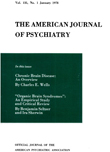Delinquency, psychomotor epileptic symptoms and paranoid ideation: a triad
Abstract
In a retrospective chart-review study, the author found psychomotor epileptic symptoms in 6% (N=18) of children referred to a juvenile court over a 2-year period. Abnormalities appeared in 11 of the 14 available EEGs, but temporal lobe foci were noted in only 3 cases. Of these 18 children, 16 experienced paranoid symptoms that led to aggressive behavior. The incidence of offenses against persons was 50% in this sample, compared to 2--3% in the population of children referred to the juvenile court. The author suggests that psychomotor epilepsy may be far more common among delinquent children than has been reported previously and should therefore be included in the differential diagnosis of court-referred children.
Access content
To read the fulltext, please use one of the options below to sign in or purchase access.- Personal login
- Institutional Login
- Sign in via OpenAthens
- Register for access
-
Please login/register if you wish to pair your device and check access availability.
Not a subscriber?
PsychiatryOnline subscription options offer access to the DSM-5 library, books, journals, CME, and patient resources. This all-in-one virtual library provides psychiatrists and mental health professionals with key resources for diagnosis, treatment, research, and professional development.
Need more help? PsychiatryOnline Customer Service may be reached by emailing [email protected] or by calling 800-368-5777 (in the U.S.) or 703-907-7322 (outside the U.S.).



